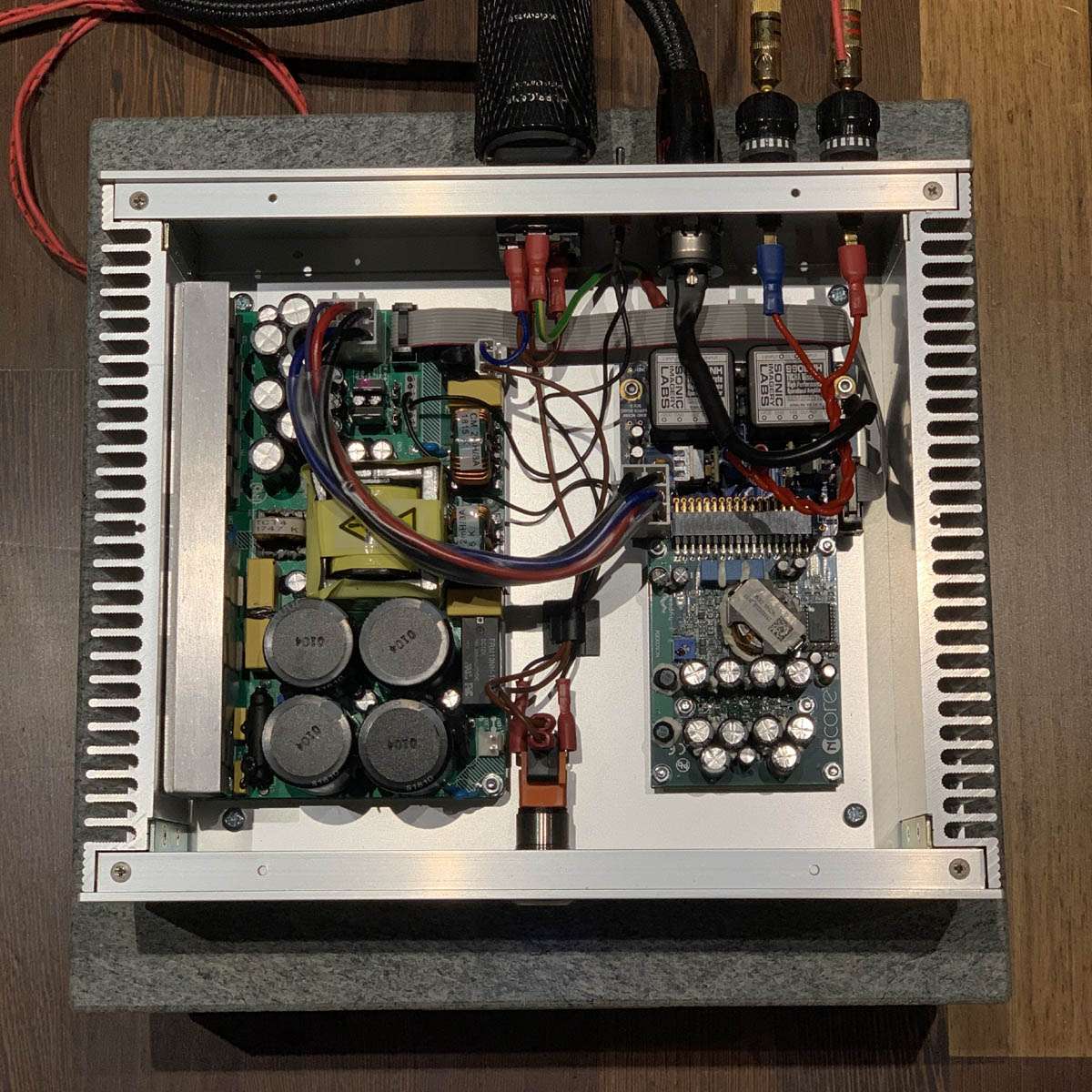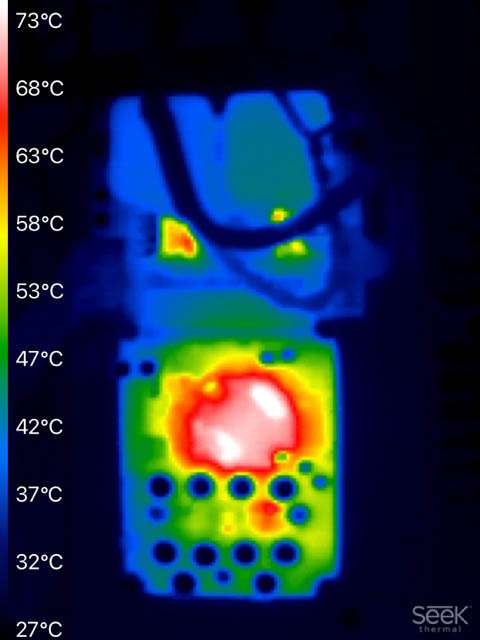- Thread Starter
- #41
Yes, a Denon is waiting for review.By the way, any chance to see you measure a highly popular mid range AV receiver from Denon and/or Marantz, such as the AVR-X3500H, SR6013 or higher models?
Yes, a Denon is waiting for review.By the way, any chance to see you measure a highly popular mid range AV receiver from Denon and/or Marantz, such as the AVR-X3500H, SR6013 or higher models?



The supply you measured is the SMPS600N400. It's a Diy only supply and I would be surprised that it's the one used here.When I performed a teardown of the DIY Hypex NC400 with the same power supply as used here, I found that to have the hottest components: https://www.audiosciencereview.com/...-hypex-nc400-diy-amp.5907/page-19#post-134676

As you see, the bottom module which is the power supply is much hotter than either (round) amplifier modules. And if my memory is right, the power supply also uses second or third-tier capacitors which means they also should be kept cool for best life.
By using two power supplies in this Nord build, the load, and the heat is spread across both of them, resulting in cooler operation. And longer life.
Related, the amplifiers dissipate their heat through the case since their power transistors are mounted to the bottom plate. The power supply on the other hand is relying on that one bent piece of aluminum for cooling so much less efficient.
When I performed a teardown of the DIY Hypex NC400 with the same power supply as used here, I found that to have the hottest components: https://www.audiosciencereview.com/...-hypex-nc400-diy-amp.5907/page-19#post-134676

As you see, the bottom module which is the power supply is much hotter than either (round) amplifier modules. And if my memory is right, the power supply also uses second or third-tier capacitors which means they also should be kept cool for best life.
By using two power supplies in this Nord build, the load, and the heat is spread across both of them, resulting in cooler operation. And longer life.
Related, the amplifiers dissipate their heat through the case since their power transistors are mounted to the bottom plate. The power supply on the other hand is relying on that one bent piece of aluminum for cooling so much less efficient.
Yes, their website specifies TWO SMPS1200's. That is 4X the nominal power supply rating in the box of the first NC400 unit Amir tested. But also, the SMPS1200 is much better on heatsinking , in that it has a large transfer plate that mounts to the case, transferring heat to the outer case, rather than to the air inside the case. I'd take a single SMPS1200 over two SMPS600s. In fact, I have. I've even worked out that I'll use a single SMPS1200 for three NC400s rather than three SMPS600s. Less total heat generated and better heat sinking. As for the benefits of an SMPS1200 for each 1ET400A, it does seem like overkill unless maybe one expected to run consistently at very high power outputs and wanted to maximize PSU life.... the NC400's in that review used 600w supplies, and this amp uses 1200w supplies. ....
As for the benefits of an SMPS1200 for each 1ET400A, it does seem like overkill unless maybe one expected to run consistently at very high power outputs and wanted to maximize PSU life.
We are using the SMPS3kA700 PSU. We started with two SMPS1200 PSU's but we were not happy with the heat generated in the transformers. When driven hard the temperature reached 120 degrees! The SMPS3kA is surprisingly much better and the hottest spot on the transformer reaches only 88 degrees under same conditions. In fact the SMPS3K is about 50% more powerful than two SMPS1200s.
More stuff to go wrong, is, more stuff to go wrong, and I'm not advocating using extra, wasted PSUs, but, I'd be quite interested to see some thermal images of the SMPS1200 under some specified output conditions. Standby current is 7W? Their higher efficiencies at lower powers probably beats this. That is, the specs indicate that the total dissipation of a box with two SMPS1200s driving two 1ET400As should be marginally lower than with one SMPS1200, or at the very least, not significantly higher, at output powers of, say, 400W / chan. And, I'd expect the operating temperatures of key devices on those PSUs to be correspondingly lower.You will not increase reliability even at high output because even if you were running the 2 Purifi modules to the clipping point all day long every day, the single 1200w supply is not working hard at all. This supply was designed to power the 3 times more powerful NC1200. And be able to do it continuously under high load. So if anything the 2nd supply will reduce reliability by raising the ambient case temp, as well as the heatsink temp. Not to mention 2 supplies to replace when they eventually fail. These supplies run almost as hot at idle as when under load.
More stuff to go wrong, is, more stuff to go wrong, and I'm not advocating using extra, wasted PSUs, but, I'd be quite interested to see some thermal images of the SMPS1200 under some specified output conditions. Standby current is 7W? Their higher efficiencies at lower powers probably beats this. That is, the specs indicate that the total dissipation of a box with two SMPS1200s driving two 1ET400As should be marginally lower than with one SMPS1200, or at the very least, not significantly higher, at output powers of, say, 400W / chan. And, I'd expect the operating temperatures of key devices on those PSUs to be correspondingly lower.
Despite all that, for a compact three channel NC400 amp build (center and rear surrounds, with sub woofers), I determined that I'd be most happy with a single SMPS1200.
but from other angles you do get the impression that there's quite a few rough edges here and there
These supplies run almost as hot at idle as when under load
.
I had an SE case Nord and I think it was fine. Not as nice as my current Sony ES, but on a par with Naim olive amps I’ve had.Also, to anyone who has actually owned any Nord products before: how's the build quality in person? I seem to be getting mixed feelings based on their online photos; from some angles their products look super well machined but from other angles you do get the impression that there's quite a few rough edges here and there in their manufacturing.
In the real world people are not going to be running these amps right to clipping continuously. The efficiency of these supplies under 400w drops down to 85% from 90%. So for 98% of most peoples listening, using dual supplies will result in the supplies operating in the lowest region of efficiency. And since there's 2 supplies instead of 1, we're now pissing away 30% of the incoming energy to heat, rather than 10%.
View attachment 39195
However what these plots don't tell us, is now both supplies are not in an ambient case air temp or heatsink temp of room temperature like they would be without a 2nd supply providing each with an external heat source. And any heat over and above room temp, is going to add directly to the max temp of each of the supplies. Not that temps are going to be an issue in the least anyways. It's just that having this 2nd supply is only really there to fool audiophiles into thinking it's better. When in reality there's nothing but disadvantages. So now if a smart manufacturer who would rather offer an amp at a lower cost by running 1 supply, or putting more money into other areas which will yield higher gains instead, audiophiles will think it sucks because it only has 1 supply. This is what we call audiophile myths, and misinformation.
